A Risk-Based Prioritization Framework for Contractual Claim Drivers in Public Construction Projects: Evidence from Kuwait
Abstract
1. Background
- Frequency of claims: How frequently do specific causes of claims arise in projects?
- Duration impact: What is the apparent influence of each claim reason on extending the project’s timeline?
- Cost overrun analysis: How do stakeholders perceive the effect of each claim trigger on escalating the project’s final expenses?
- Quality implications: To what extent are project quality standards compromised by these claim-related causes, as perceived by industry professionals?
- Risk prioritization: Which five claim causes, when assessed for their combined probability of occurrence and multidimensional impacts (time, cost, and quality), rank as the most critical threats to the successful performance of construction contracts?
2. Study Methodology
2.1. Cause of Claims Breakdown Structure (CCBS)
| Research Scope | Authors (Year, Data Source) | Causes | Country |
|---|---|---|---|
| Bibliometric review of construction claim research | Olalekan et al. [9] (2021, LR); Mohammadi and Birgonu [7] (2016, Q); Cakmak [17] (2014, Q/CS) | 0 | International |
| Claims management | Abdul-Malak et al. [30] (2002, LR); Al-Sabah et al. [31] (2003, LR); Barman et al. [32] (2017, CS); Chan et al. [33] (2005, LR); Chan et al. [34] (2006, I); Cheung and Pang [35] (2013, LR); Cheung and Suen [36] (2002, LR/I); Cheung et al. [37] (2019, CS); Diekmann and Girard [38] (1995, Q/CS); Gardiner and Simmons [39] (1998, I/CS); Gould [40] (1998, Q); Ho and Liu [41] (2004, LR) | Various | Multiple (e.g., USA, UK, Turkey, Greece/UK) |
| Causes of claims | Ilter and Bakioglu [42] (2018, CS); Jahren and Dammeier [43] (1990, I); Kartam [44] (1999, LR); Kilian et al. [45] (2005, CS); Kululanga et al. [46] (2001, Q/CS); Kumaraswamy [47] (1998, LR/Q/CS) | Various | Multiple (e.g., Malaysia, Iraq, India, Turkey) |
| Dispute resolution | Ballesteros-Pérez [13] (2017, LR); Chau [15] (2007, LR); Cheung et al. [35] (2013, Q); Ren and Anumba [48] (2002, LR); Ren et al. [49] (2003, CS); Ren et al. [50] (2002, LR) | Various | Multiple (e.g., Spain, Hong Kong, UK) |
| Dispute development process | Mitropoulos and Howell [6] (2001, LR); Scott and Harris [51] (2004, Q/I); Semple et al. [52] (1994, CS); Stamatiou et al. [53] (2019, LR); Treacy [54] (1995, LR); Vidogah and Ndekugri [55] (1997, Q/I/CS); Viswanathan et al. [56] (2020, LR/Q); Wong and Maric [57] (2016, CS) | 14 | USA |
| Investment risks | Yogeswaran et al. [58] (1998, CS); Bakhary et al. [22] (2015, Q) | 4 | Turkey |
| Bibliometric review of construction claim research | Ren and Anumba [50] (2002, LR); Ren et al. [49] (2003, CS); Yuan and Ma [59] (2012, LR); Zaneldin [27] (2006, Q/CS) | Various | Not specified |
- A.
- Contractual Issues
- A1. Ambiguities in contract language
- A2. Changes in scope
- A3. Delays in approvals
- B.
- Project Management Factors
- B1. Inadequate planning
- B2. Poor resource allocation
- B3. Ineffective communication among stakeholders
- C.
- External Factors
- C1. Weather-related disruptions
- C2. Regulatory changes
- C3. Economic fluctuations
- D.
- Technical Issues
- D1. Design flaws
- D2. Construction defects
- D3. Equipment failures
- E.
- Human Factors
- E1. Labor disputes
- E2. Skill shortages
- E3. Mismanagement of teams
2.2. Data Collection
2.3. Data Analysis Methodology
- m: The number of digits on the scale. In this case, (since the scale ranges from 1 to 5);
- Pi: The rating values, which take on values from 1 to 5, indicating increasing levels of frequency;
- Ui: The number of respondents who selected each rating Pi;
- N: The total number of respondents;
- n: The possible rating on the scale, which is also 5 in this case.
3. Results and Discussion
3.1. Personal Characteristics
3.2. Relative Importance Indices (RII)
3.3. Risk Analysis
3.4. Expert Suggestions for Mitigation Measures
4. Conclusions
Author Contributions
Funding
Data Availability Statement
Conflicts of Interest
References
- Monastiriotis, V.; Psycharis, Y. Between Equity, Efficiency and Redistribution: An Analysis of Revealed Allocation Criteria of Regional Public Investment in Greece. Eur. Urban Reg. Stud. 2014, 21, 445–462. [Google Scholar] [CrossRef]
- Cheung, S.O.; Yiu, T.W. Are Construction Disputes Inevitable? IEEE Trans. Eng. Manag. 2006, 53, 456–470. [Google Scholar] [CrossRef]
- Mishmish, M.; El-Sayegh, S.M. Causes of Claims in Road Construction Projects in the UAE. Int. J. Constr. Manag. 2018, 18, 26–33. [Google Scholar] [CrossRef]
- Chaphalkar, N.B.; Iyer, K.C.; Patil, S.K. Prediction of Outcome of Construction Dispute Claims Using Multilayer Perceptron Neural Network Model. Int. J. Proj. Manag. 2015, 33, 1827–1835. [Google Scholar] [CrossRef]
- Naji, K.K.; Mansour, M.M.; Gunduz, M. Methods for Modeling and Evaluating Construction Disputes: A Critical Review. IEEE Access 2020, 8, 45641–45652. [Google Scholar] [CrossRef]
- Mitropoulos, P.; Howell, G. Model for Understanding, Preventing, and Resolving Project Disputes. J. Constr. Eng. Manag. 2001, 127, 223–231. [Google Scholar] [CrossRef]
- Mohammadi, S.; Birgonul, M.T. Preventing Claims in Green Construction Projects through Investigating the Components of Contractual and Legal Risks. J. Clean. Prod. 2016, 139, 1078–1084. [Google Scholar] [CrossRef]
- Aibinu, A.A.; Ling, F.Y.Y.; Ofori, G. Structural Equation Modelling of Organizational Justice and Cooperative Behaviour in the Construction Project Claims Process: Contractors’ Perspectives. Constr. Manag. Econ. 2011, 29, 463–481. [Google Scholar] [CrossRef]
- Olalekan, O.T.; Ariffin, H.L.B.T.; Ali, K.N.; Raslim, F.M.; Mohamad, M.B. Bibliometric Analysis of Construction Dispute. Malays. Constr. Res. J. Spec. Issue 2021, 12, 64. [Google Scholar]
- Ali, B.; Zahoor, H.; Nasir, A.R.; Maqsoom, A.; Khan, R.W.A.; Mazher, K.M. BIM-Based Claims Management System: A Centralized Information Repository for Extension of Time Claims. Autom. Constr. 2020, 110, 102937. [Google Scholar] [CrossRef]
- Arditi, D.; Pattanakitchamroon, T. Selecting a Delay Analysis Method in Resolving Construction Claims. Int. J. Proj. Manag. 2006, 24, 145–155. [Google Scholar] [CrossRef]
- Yusuwan, N.M.; Adnan, H. Issues Associated with Extension of Time (EoT) Claim in Malaysian Construction Industry. Procedia Technol. 2013, 9, 740–749. [Google Scholar] [CrossRef]
- Ballesteros-Pérez, P.; Rojas-Céspedes, Y.A.; Hughes, W.; Kabiri, S.; Pellicer, E.; Mora-Melià, D.; del Campo-Hitschfeld, M.L. Weather-Wise: AWeather-Aware Planning Tool for Improving Construction Productivity and Dealing with Claims. Autom. Constr. 2017, 84, 81–95. [Google Scholar] [CrossRef]
- Yousefi, V.; Yakhchali, S.H.; Khanzadi, M.; Mehrabanfar, E.; Šaparauskas, J. Proposing a Neural Network Model to Predict Time and Cost Claims in Construction Projects. J. Civ. Eng. Manag. 2016, 22, 967–978. [Google Scholar] [CrossRef]
- Chau, K.W. Application of a PSO-Based Neural Network in Analysis of Outcomes of Construction Claims. Autom. Constr. 2007, 16, 642–646. [Google Scholar] [CrossRef]
- Mukilan, K.; Rameshbabu, C.; Baranitharan, B.; Muthusamy, S.; Ramamoorthi, P.; Sadasivuni, K.K.; Oflaz, K.; Khan, A. An efficient claim management assurance system using EPC contract based on improved monarch butterfly optimization models. Neural Comput. Appl. 2024, 37, 169–184. [Google Scholar] [CrossRef]
- Cakmak, E.; Cakmak, P.I. An Analysis of Causes of Disputes in the Construction Industry Using Analytical Network Process. Procedia Soc. Behav. Sci. 2014, 109, 183–187. [Google Scholar] [CrossRef]
- Iskandar; Hardjomuljadi, S.; Sulistio, H. The Most Influencing Factors on the Causes of Construction Claims and Disputes in the EPC Contract Model of Infrastructure Projects in Indonesia. Rev. Int. Geogr. Educ. (RIGEO) 2021, 11, 80–91. [Google Scholar]
- Deacon, H.; Kajimo-Shakantu, K.; Le Roux, K. Contract administrators’ perspective on claim events under the JBCC Principal Building Agreement in South Africa. Acta Structilia 2023, 30, 124–160. [Google Scholar] [CrossRef]
- Abdul Nabi, M.; El-adaway, I.H. Understanding Disputes in Modular Construction Projects: Key Common Causes and Their Associations. J. Constr. Eng. Manag. 2022, 148, 04021184. [Google Scholar] [CrossRef]
- Ghosh, B.; Karmakar, S. Assessing the causes of claims in highway construction projects with a case study: A construction practitioner’s perspective. Asian J. Civ. Eng. 2024, 25, 3035–3048. [Google Scholar] [CrossRef]
- Bakhary, N.A.; Adnan, H.; Ibrahim, A. A Study of Construction Claim Management Problems in Malaysia. Procedia Econ. Financ. 2015, 23, 63–70. [Google Scholar] [CrossRef]
- Kisi, K.P.; Lee, N.; Kayastha, R.; Kovel, J. Alternative Dispute Resolution Practices in International Road Construction Contracts. J. Leg. Aff. Disput. Resolut. Eng. Constr. 2020, 12, 04520001. [Google Scholar] [CrossRef]
- Shen, W.; Tang, W.; Yu, W.; Duffield, C.F.; Hui, F.K.P.; Wei, Y.; Fang, J. Causes of Contractors’ Claims in International Engineering- Procurement-Construction Projects. J. Civ. Eng. Manag. 2017, 23, 727–739. [Google Scholar] [CrossRef]
- Ibraheem, R.A.R.; Mahjoob, A.M.R. Facilitating Claims Settlement Using Building Information Modeling in the School Building Projects. Innov. Infrastruct. Solut. 2022, 7, 40. [Google Scholar] [CrossRef]
- Antoniou, F.; Tsioulpa, A.V. Assessing the Delay, Cost, and Quality Risks of Claims on Construction Contract Performance. Buildings 2024, 14, 333. [Google Scholar] [CrossRef]
- Zaneldin, E.K. Construction Claims in United Arab Emirates: Types, Causes, and Frequency. Int. J. Project Manag. 2006, 24, 453–459. [Google Scholar] [CrossRef]
- Abdelalim, A.M.; Al-Sabah, R.; Salem, M.; Said, S.O.; Tantawy, M.; Ezz Al-Regal, M.R. Variations and Claims in International Construction Projects in the MENA Region from the Last Decade. Buildings 2024, 14, 2496. [Google Scholar] [CrossRef]
- Ayyub, B.M. Risk Analysis in Engineering and Economics, 2nd ed.; CRC Press, Taylor and Francis Group: Boca Raton, FL, USA, 2014. [Google Scholar]
- Abdul-Malak, M.A.U.; El-Saadi, M.M.H.; Abou-Zeid, M.G. Process Model for Administrating Construction Claims. J. Manag. Eng. 2002, 18, 84–94. [Google Scholar] [CrossRef]
- Al-Sabah, S.S.J.A.; Fereig, S.M.; Hoare, D.J. A Database Management System to Document and Analyse Construction Claims. Adv. Eng. Softw. 2003, 34, 477–491. [Google Scholar] [CrossRef]
- Barman, A.; Charoenngam, C. Decisional Uncertainties in Construction Projects as a Cause of Disputes and Their Formal Legal Interpretation by the Courts: Review of Legal Cases in the United Kingdom. J. Leg. Aff. Disput. Resolut. Eng. Constr. 2017, 9, 04517011. [Google Scholar] [CrossRef]
- Chan, E.H.W.; Suen, H.C.H. Disputes and Dispute Resolution Systems in Sino-Foreign Joint Venture Construction Projects in China. J. Prof. Issues Eng. Educ. Pract. 2005, 131, 141–148. [Google Scholar] [CrossRef]
- Chan, E.H.; Suen, H.C.; Chan, C.K. MAUT-Based Dispute Resolution Selection Model Prototype for International Construction Projects. J. Constr. Eng. Manag. 2006, 132, 444–451. [Google Scholar] [CrossRef]
- Cheung, S.O.; Pang, K.H.Y. Anatomy of Construction Disputes. J. Constr. Eng. Manag. 2013, 139, 15–23. [Google Scholar] [CrossRef]
- Cheung, S.O.; Suen, H.C.H. A Multi-Attribute Utility Model for Dispute Resolution Strategy Selection. Constr. Manag. Econ. 2002, 20, 557–568. [Google Scholar] [CrossRef]
- Cheung, S.O.; Li, K.; Levina, B. Paradox of Bias and Impartiality in Facilitating Construction Dispute Resolution. J. Leg. Aff. Disput. Resolut. Eng. Constr. 2019, 11, 04519007. [Google Scholar] [CrossRef]
- Diekmann, J.E.; Girard, M.J. Are Contract Disputes Predictable? J. Constr. Eng. Manag. 1995, 121, 355–363. [Google Scholar] [CrossRef]
- Gardiner, P.D.; Simmons, J.E.L. Conflict in Small- and Medium-Sized Projects: Case of Partnering to the Rescue. J. Manag. Eng. 1998, 14, 35–40. [Google Scholar] [CrossRef]
- Gould, N. Alternative Dispute Resolution in the UK Construction Industry. In Proceedings of the 14th Annual ARCOM Conference, Reading, UK, 9–11 September 1998; Volume 2. [Google Scholar]
- Ho, S.P.; Liu, L.Y. Analytical Model for Analyzing Construction Claims and Opportunistic Bidding. J. Constr. Eng. Manag. 2004, 130, 94–104. [Google Scholar] [CrossRef]
- Ilter, A.D.; Bakioglu, G. Modeling the Relationship between Risk and Dispute in Subcontractor Contracts. J. Leg. Aff. Disput. Resolut. Eng. Constr. 2018, 10, 04517022. [Google Scholar] [CrossRef]
- Jahren, C.T.; Dammeier, B.F. Investigation into Construction Disputes. J. Manag. Eng. 1990, 6, 39–46. [Google Scholar] [CrossRef]
- Kartam, S. Generic Methodology for Analyzing Delay Claims. J. Constr. Eng. Manag. 1999, 125, 409–419. [Google Scholar] [CrossRef]
- Kilian, J.J.; Gibson, G.E.; Asce, M. Construction Litigation for the U.S. Naval Facilities Engineering Command, 1982–2002. J. Constr. Eng. Manag. 2005, 131, 945–952. [Google Scholar] [CrossRef]
- Kululanga, G.K.; Kuotcha, W.; Mccaffer, R.; Edum-Fotwe, F. Construction Contractors’ Calaim Process Framework. J. Constr. Eng. Manag. 2001, 127, 309–314. [Google Scholar] [CrossRef]
- Kumaraswamy, M.M. Consequences of Construction Conflict: A Hong Kong Perspective. J. Manag. Eng. 1998, 14, 66–74. [Google Scholar] [CrossRef]
- Ren, Z.; Anumba, C.J. Learning in Multi-Agent Systems: A Case Study of Construction Claims Negotiation. Adv. Eng. Inform. 2002, 16, 265–275. [Google Scholar] [CrossRef]
- Ren, Z.; Anumba, C.J.; Ugwu, O.O. The Development of a Multi-Agent System for Construction Claims Negotiation. Adv. Eng. Softw. 2003, 34, 683–696. [Google Scholar] [CrossRef]
- Ren, Z.; Anumba, C.J.; Ugwu, O.O. Negotiation in a Multi-Agent System for Construction Claims Negotiation. Appl. Artif. Intell. 2002, 16, 359–394. [Google Scholar] [CrossRef]
- Scott, S.; Harris, R.A. United Kingdom Construction Claims: Views of Professionals. J. Constr. Eng. Manag. 2004, 130, 734–741. [Google Scholar] [CrossRef]
- Semple, C.; Hartman, F.T.; Jergeas, G. Construction Claims and Disputes: Causes and Cost/Time Overruns. J. Constr. Eng. Manag. 1994, 120, 785–795. [Google Scholar] [CrossRef]
- Stamatiou, D.R.I.; Kirytopoulos, K.A.; Ponis, S.T.; Gayialis, S.; Tatsiopoulos, I. A Process Reference Model for Claims Management in Construction Supply Chains: The Contractors’ Perspective. Int. J. Constr. Manag. 2019, 19, 382–400. [Google Scholar] [CrossRef]
- Treacy, T.B. Use of Alternative Dispute Resolution in the Construction Industry. J. Manag. Eng. 1995, 11, 58–63. [Google Scholar] [CrossRef]
- Vidogah, W.; Ndekugri, I. Improving Management of Claims: Contractors’ Perspective. J. Manag. Eng. 1997, 13, 37–44. [Google Scholar] [CrossRef]
- Viswanathan, S.K.; Panwar, A.; Kar, S.; Lavingiya, R.; Jha, K.N. Causal Modeling of Disputes in Construction Projects. J. Leg. Aff. Disput. Resolut. Eng. Constr. 2020, 12, 04520035. [Google Scholar] [CrossRef]
- Wong, P.S.P.; Maric, D. Causes of Disputes in Construction Planning Permit Applications. J. Leg. Aff. Disput. Resolut. Eng. Constr. 2016, 8, 04516006. [Google Scholar] [CrossRef]
- Yogeswaran, K.; Kumaraswamy, M.M.; Miller, D.R.A. Claims for Extensions of Time in Civil Engineering Projects. Constr. Manag. Econ. 1998, 16, 283–293. [Google Scholar] [CrossRef]
- Yuan, H.; Ma, H. Game Analysis in the Construction Claim Negotiations. Procedia Eng. 2012, 28, 586–593. [Google Scholar] [CrossRef]
- Creswell, J.W. Research Design. Qualitative, Quantitative and Mixed Methods Approaches, 4th ed.; Sage Publications: Thousand Oaks, CA, USA, 2014. [Google Scholar]
- AlJaber, A.; Martinez-Vazquez, P.; Baniotopoulos, C. Developing Critical Success Factors for Implementing Circular Economy in Building Construction Projects. Buildings 2024, 14, 2319. [Google Scholar] [CrossRef]
- Arantes, A.; Ferreira, L.M.D.F. A Methodology for the Development of Delay Mitigation Measures in Construction Projects. Prod. Plan. Control 2021, 32, 228–241. [Google Scholar] [CrossRef]
- Keng, T.C.; Mansor, N.; Ching, Y.K. An Exploration of Cost Overrun in Building Construction Projects. Glob. Bus. Manag. Res. Int. J. 2018, 10, 638–646. [Google Scholar]
- Antoniou, F.; Aretoulis, G.N.; Konstantinidis, D.K.; Kalfakakou, G.P. An Empirical Study of Researchers’ and Practitioners’ Views on Compensating Major Highway Project Contractors. Int. J. Manag. Decis. Mak. 2013, 12, 351–375. [Google Scholar] [CrossRef]
- Antoniou, F.; Konstantinidis, D.; Aretoulis, G.N. Application of the Multi Attribute Utility Theory for the Selection of Project Procurement System for Greek Highway Projects. Int. J. Manag. Decis. Mak. 2016, 15, 83–112. [Google Scholar] [CrossRef]
- Noorzai, E. Performance Analysis of Alternative Contracting Methods for Highway Construction Projects: Case Study for Iran. J. Infrastruct. Syst. 2020, 26, 04020003. [Google Scholar] [CrossRef]
- Aretoulis, G.N.; Papathanasiou, J.; Antoniou, F. PROMETHEE-Based Ranking of Project Managers Based on the Five Personality Traits. Kybernetes 2020, 49, 1083–1102. [Google Scholar] [CrossRef]
- Antoniou, F.; Demertzidou, F.; Mentzelou, P.; Konstantinidis, D. Energy Upgrading of Buildings in Greece with Eco-Materials: An Investigation of Public Awareness. In Proceedings of the 3rd International Conference on Environmental Design (ICED2022), Athens, Greece, 22–23 October 2022; IOP Conference Series: Earth and Environmental Science. Institute of Physics, IOP Publishing: Bristol, UK, 2022; Volume 1123. [Google Scholar]
- Antoniou, F.; Merkouri, M. Accident Factors per Construction Type and Stage: A Synthesis of Scientific Research and Professional Experience. Int. J. Inj. Contr Saf. Promot. 2021, 28, 439–453. [Google Scholar] [CrossRef]
- Bryman, A. Social Research Methods; Oxford University Press Inc.: New York, NY, USA, 2012. [Google Scholar]
- Amoatey, C.T.; Ankrah, A.N.O. Exploring Critical Road Project Delay Factors in Ghana. J. Facil. Manag. 2017, 15, 110–127. [Google Scholar] [CrossRef]
- Kaliba, C.; Muya, M.; Mumba, K. Cost Escalation and Schedule Delays in Road Construction Projects in Zambia. Int. J. Proj. Manag. 2009, 27, 522–531. [Google Scholar] [CrossRef]
- Mahamid, I.; Bruland, A.; Dmaidi, N. Causes of Delay in Road Construction Projects. J. Manag. Eng. 2012, 28, 300–310. [Google Scholar] [CrossRef]
- Antoniou, F. Delay Risk Assessment Models for Road Projects. Systems 2021, 9, 70. [Google Scholar] [CrossRef]
- Antoniou, F.; Agrafioti, N.F. Meta-Analysis of Studies on Accident Contributing Factors in the Greek Construction Industry. Sustainability 2023, 15, 2357. [Google Scholar] [CrossRef]
- Holt, G.D. Asking Questions, Analysing Answers: Relative Importance Revisited. Constr. Innov. 2014, 14, 2–16. [Google Scholar] [CrossRef]
- Field, A. Discovering Statistics Using SPSS; SAGE Publications Ltd.: London, UK, 2009. [Google Scholar]
- Chen, Y.; Okudan, G.E.; Riley, D.R. Sustainable Performance Criteria for Construction Method Selection in Concrete Buildings. Autom. Constr. 2010, 19, 235–244. [Google Scholar] [CrossRef]
- PMI. A Guide to the Project Management Body of Knowledge (PMBOK® Guide), 6th ed.; Project Management Institute: Newtown Square, PA, USA, 2017. [Google Scholar]
- Zou, P.X.W.; Zhang, G.; Wang, J. Understanding the Key Risks in Construction Projects in China. Int. J. Project Manag. 2007, 25, 601–614. [Google Scholar] [CrossRef]
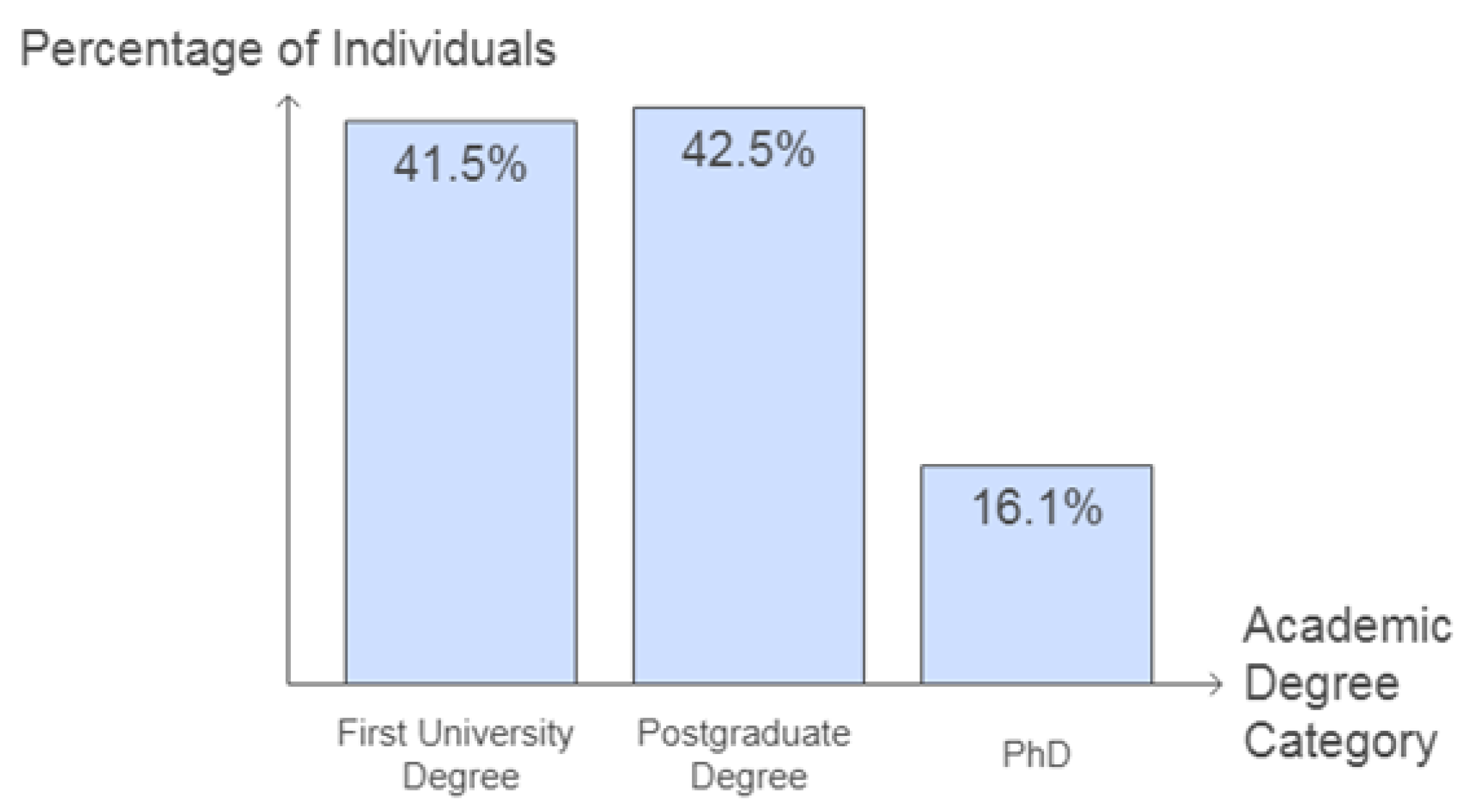
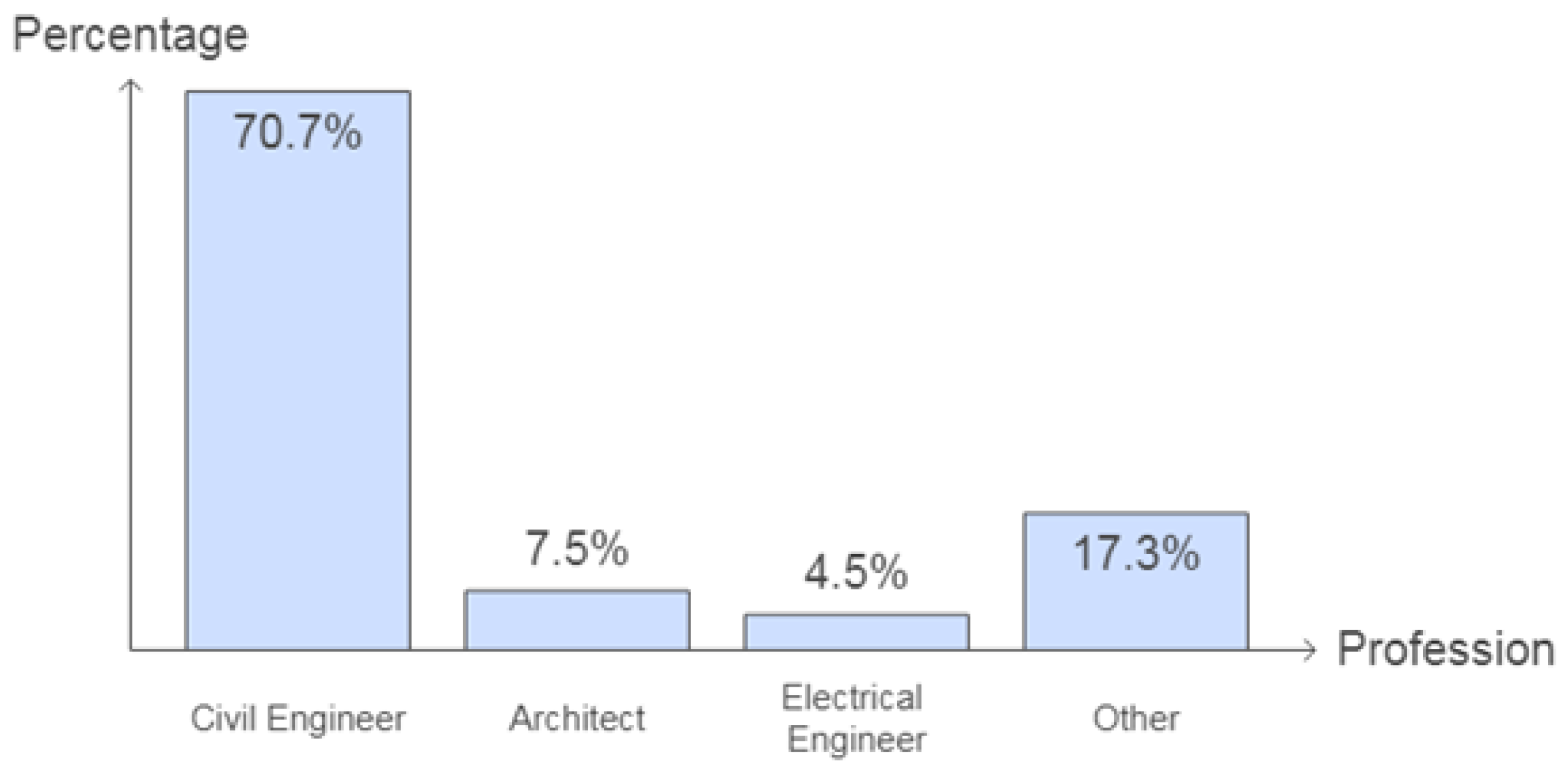
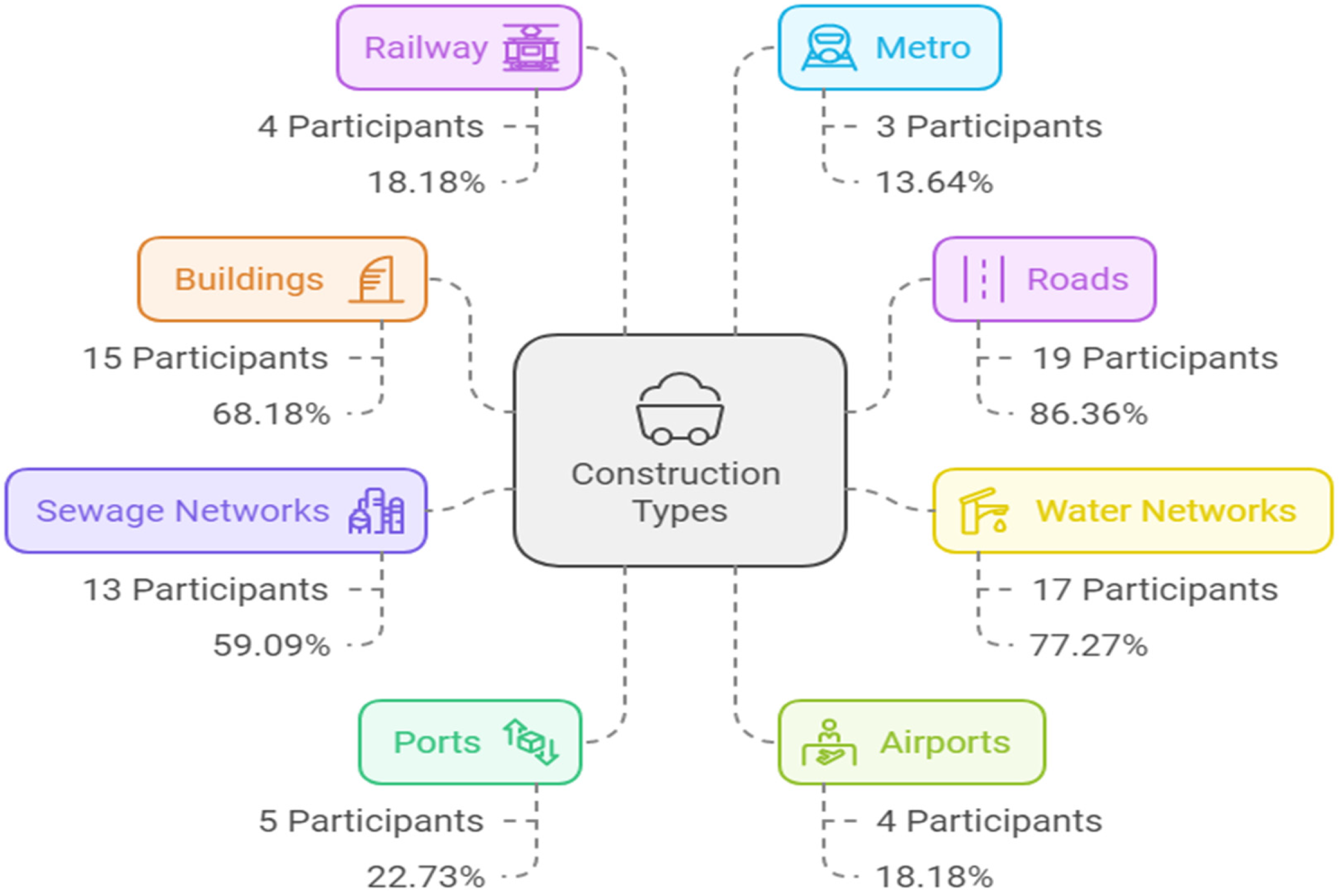
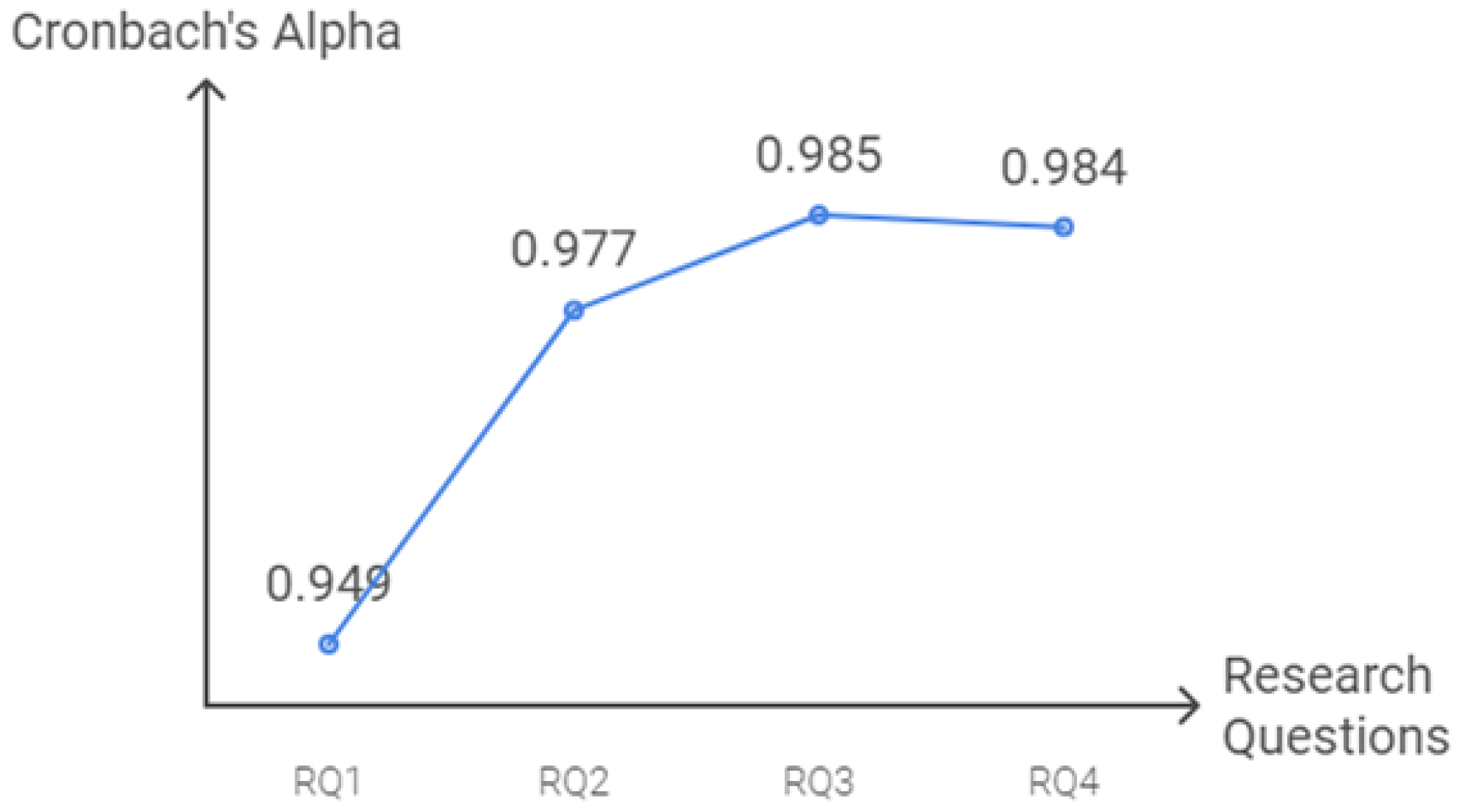
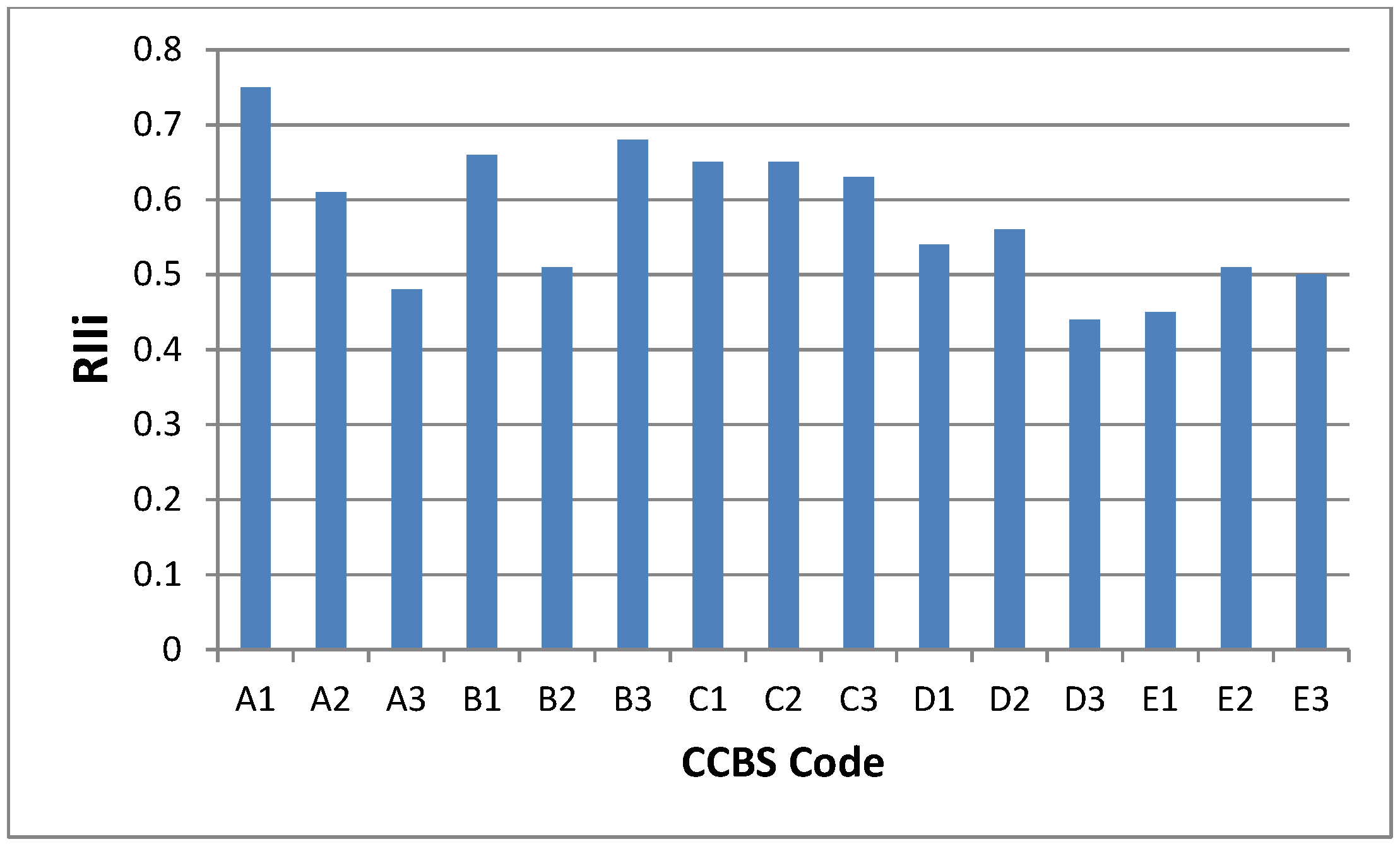
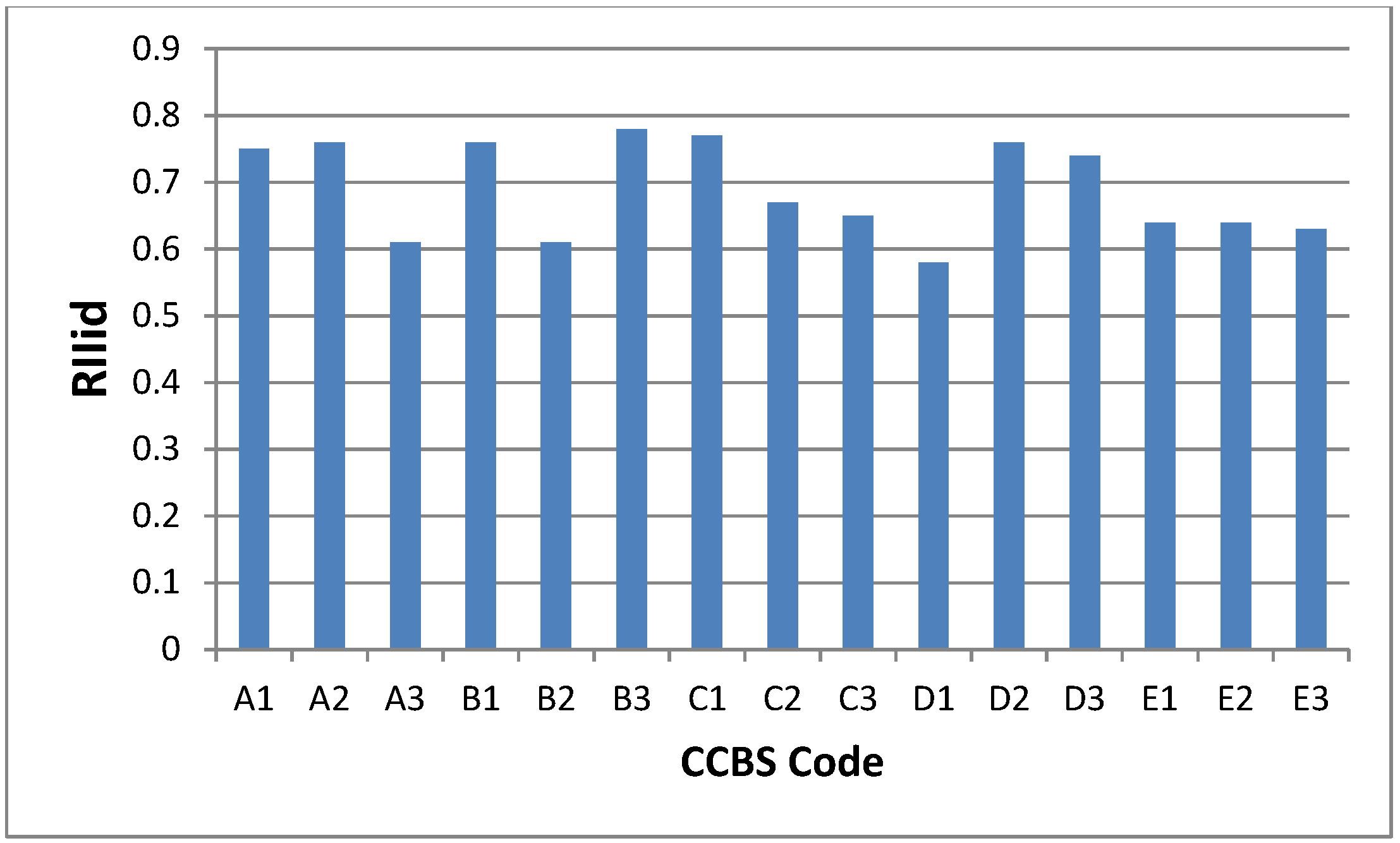
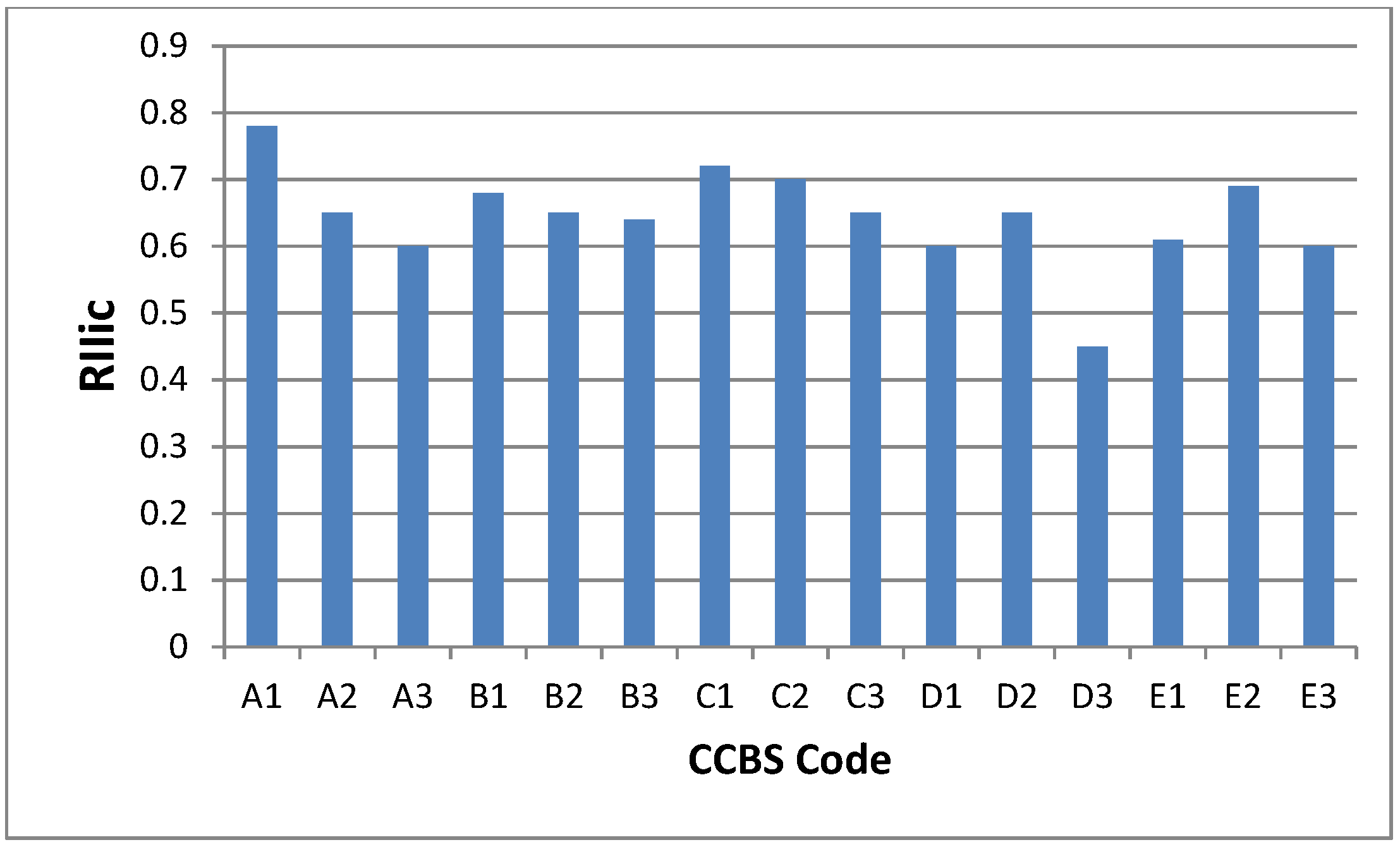
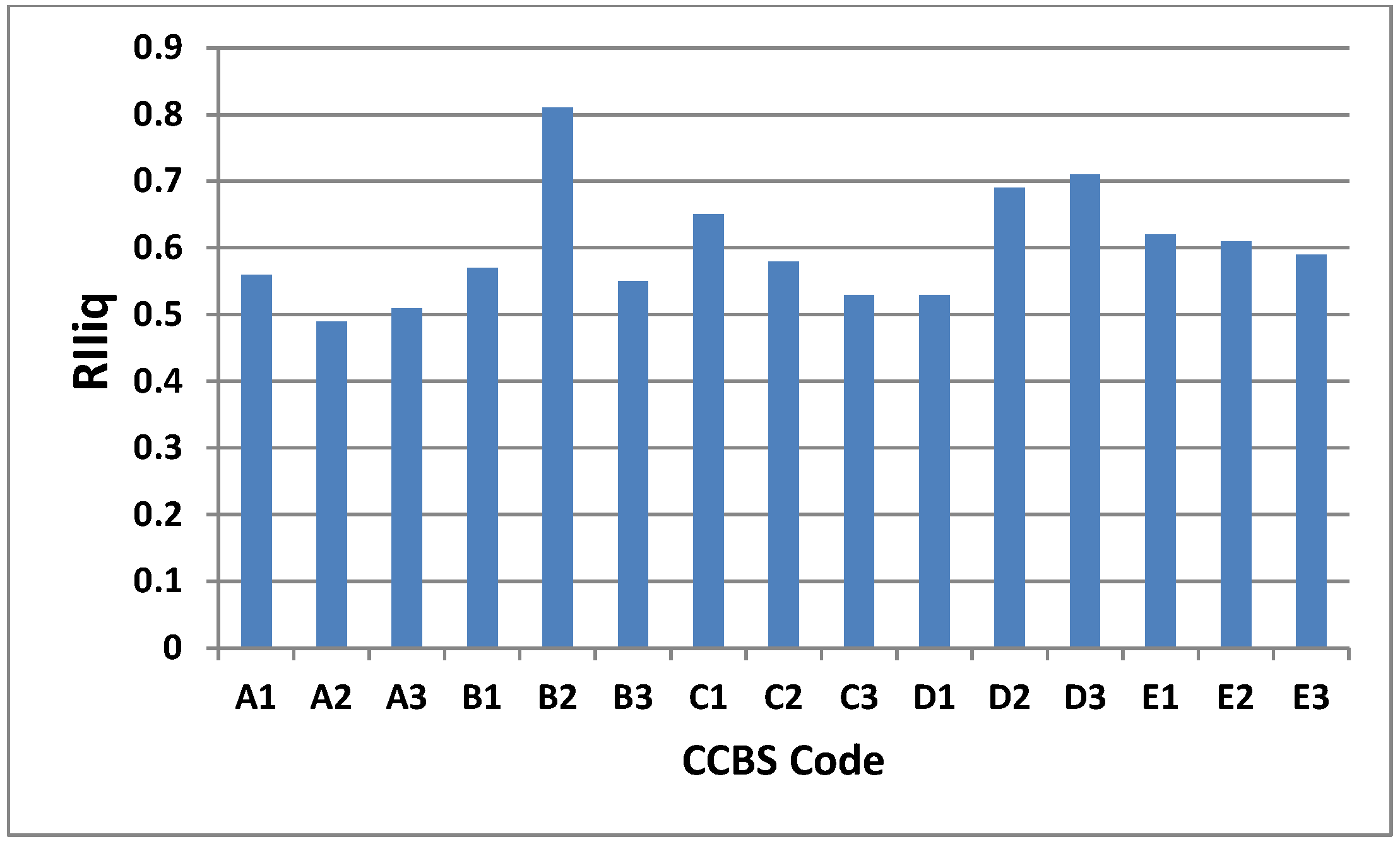
| Code | Factor | No. of Occurrences in Literature | Frequency of Occurrence (Mean, RIIi) | Impact on Time (Mean, RIIid) | Impact on Cost (Mean, RIIic) | Impact on Quality (Mean, RIIiq) |
|---|---|---|---|---|---|---|
| A1 | Ambiguities in contract language | 28 | 3.73 (0.75) | 3.77 (0.75) | 3.91 (0.78) | 2.82 (0.56) |
| A2 | Changes in scope | 14 | 3.05 (0.61) | 3.82 (0.76) | 3.23 (0.65) | 2.45 (0.49) |
| A3 | Delays in approvals | 23 | 2.41 (0.48) | 3.05 (0.61) | 3.00 (0.60) | 2.55 (0.51) |
| B1 | Inadequate planning | 24 | 3.32 (0.66) | 3.82 (0.76) | 3.41 (0.68) | 2.86 (0.57) |
| B2 | Poor resource allocation | 22 | 3.41 (0.51) | 3.91 (0.61) | 3.18 (0.65) | 2.73 (0.81) |
| B3 | Ineffective comm. among stakeholders | 11 | 2.82 (0.68) | 3.82 (0.78) | 3.27 (0.64) | 3.45 (0.55) |
| C1 | Weather-related disruptions | 17 | 3.23 (0.65) | 3.86 (0.77) | 3.59 (0.72) | 3.23 (0.65) |
| C2 | Regulatory changes | 12 | 3.23 (0.65) | 3.36 (0.67) | 3.50 (0.70) | 2.91 (0.58) |
| C3 | Economic fluctuations | 8 | 3.14 (0.63) | 3.23 (0.65) | 3.23 (0.65) | 2.64 (0.53) |
| D1 | Design flaws | 11 | 2.68 (0.54) | 2.91 (0.58) | 3.00 (0.60) | 2.64 (0.53) |
| D2 | Construction defects | 17 | 2.18 (0.56) | 3.68 (0.76) | 3.36 (0.65) | 3.55 (0.69) |
| D3 | Equipment failures | 10 | 2.27 (0.44) | 3.18 (0.74) | 3.05 (0.45) | 3.09 (0.71) |
| E1 | Labor disputes | 13 | 3.73 (0.45) | 3.77 (0.64) | 3.91 (0.61) | 2.82 (0.62) |
| E2 | Skill shortages | 13 | 3.05 (0.51) | 3.82 (0.64) | 3.23 (0.69) | 2.45 (0.61) |
| E3 | Mismanagement of teams | 9 | 2.41 (0.50) | 3.05 (0.63) | 3.00 (0.60) | 2.55 (0.59) |
| Frequency | (RIIi) | Rank | Duration | (RIIid) | Rank | Cost | (RIIic) | Rank | Quality | (RIIiq) | Rank |
|---|---|---|---|---|---|---|---|---|---|---|---|
| A1 | (0.75) | 1 | B3 | (0.78) | 1 | A1 | (0.78) | 1 | B2 | (0.81) | 1 |
| B3 | (0.68) | 2 | C1 | (0.77) | 2 | C1 | (0.72) | 2 | D3 | (0.71) | 2 |
| B1 | (0.66) | 3 | A2 | (0.76) | 3 | C2 | (0.70) | 3 | D2 | (0.69) | 3 |
| C1 | (0.65) | 4 | B1 | (0.76) | 4 | E2 | (0.69) | 4 | C1 | (0.65) | 4 |
| C2 | (0.65) | 5 | D2 | (0.76) | 5 | B1 | (0.68) | 5 | E1 | (0.62) | 5 |
| C3 | (0.63) | 6 | A1 | (0.75) | 6 | A2 | (0.65) | 6 | E2 | (0.61) | 6 |
| A2 | (0.61) | 7 | D3 | (0.74) | 7 | B2 | (0.65) | 7 | E3 | (0.59) | 7 |
| D2 | (0.56) | 8 | C2 | (0.67) | 8 | C3 | (0.65) | 8 | C2 | (0.58) | 8 |
| D1 | (0.54) | 9 | C3 | (0.65) | 9 | D2 | (0.65) | 9 | B1 | (0.57) | 9 |
| B2 | (0.51) | 10 | E1 | (0.64) | 10 | B3 | (0.64) | 10 | A1 | (0.56) | 10 |
| E2 | (0.51) | 11 | E2 | (0.64) | 11 | E1 | (0.61) | 11 | B3 | (0.55) | 11 |
| E3 | (0.50) | 12 | E3 | (0.63) | 12 | A3 | (0.60) | 12 | C3 | (0.53) | 12 |
| A3 | (0.48) | 13 | A3 | (0.61) | 13 | D1 | (0.60) | 13 | D1 | (0.53) | 13 |
| E1 | (0.45) | 14 | B2 | (0.61) | 14 | E3 | (0.60) | 14 | A3 | (0.51) | 14 |
| D3 | (0.44) | 15 | D1 | (0.58) | 15 | D3 | (0.45) | 15 | A2 | (0.49) | 15 |
| CCBS Code | RVDi | Rank RVDi | RVCi | Rank RVCi | RVQi | Rank RVQi | TRV1 | Rank TRV1 | TRV2 | Rank TRV2 |
|---|---|---|---|---|---|---|---|---|---|---|
| A1 | 0.56 | 1 | 0.59 | 1 | 0.42 | 2 | 0.53 | 1 | 0.55 | 1 |
| A2 | 0.46 | 5 | 0.40 | 10 | 0.30 | 12 | 0.41 | 7 | 0.39 | 7 |
| A3 | 0.29 | 13 | 0.29 | 14 | 0.24 | 14 | 0.28 | 14 | 0.28 | 14 |
| B1 | 0.50 | 3 | 0.45 | 4 | 0.38 | 4 | 0.46 | 4 | 0.45 | 3 |
| B2 | 0.31 | 11 | 0.33 | 12 | 0.41 | 3 | 0.34 | 10 | 0.35 | 9 |
| B3 | 0.53 | 2 | 0.44 | 5 | 0.37 | 5 | 0.47 | 3 | 0.44 | 4 |
| C1 | 0.50 | 4 | 0.47 | 3 | 0.42 | 1 | 0.48 | 2 | 0.47 | 2 |
| C2 | 0.44 | 6 | 0.46 | 2 | 0.38 | 6 | 0.43 | 5 | 0.45 | 5 |
| C3 | 0.41 | 7 | 0.41 | 7 | 0.33 | 10 | 0.39 | 8 | 0.40 | 6 |
| D1 | 0.31 | 10 | 0.32 | 13 | 0.29 | 13 | 0.31 | 12 | 0.31 | 12 |
| D2 | 0.43 | 8 | 0.36 | 9 | 0.39 | 8 | 0.40 | 6 | 0.38 | 8 |
| D3 | 0.33 | 9 | 0.20 | 15 | 0.31 | 11 | 0.29 | 13 | 0.26 | 15 |
| E1 | 0.29 | 14 | 0.27 | 16 | 0.28 | 15 | 0.28 | 15 | 0.28 | 13 |
| E2 | 0.33 | 12 | 0.35 | 11 | 0.31 | 9 | 0.33 | 11 | 0.34 | 10 |
| E3 | 0.32 | 15 | 0.30 | 15 | 0.30 | 12 | 0.31 | 12 | 0.31 | 11 |
Disclaimer/Publisher’s Note: The statements, opinions and data contained in all publications are solely those of the individual author(s) and contributor(s) and not of MDPI and/or the editor(s). MDPI and/or the editor(s) disclaim responsibility for any injury to people or property resulting from any ideas, methods, instructions or products referred to in the content. |
© 2025 by the authors. Licensee MDPI, Basel, Switzerland. This article is an open access article distributed under the terms and conditions of the Creative Commons Attribution (CC BY) license (https://creativecommons.org/licenses/by/4.0/).
Share and Cite
Abdel-Hamid, M.; Almutairi, N.S.; Musleh, N.; Abdelhaleem, H.M. A Risk-Based Prioritization Framework for Contractual Claim Drivers in Public Construction Projects: Evidence from Kuwait. Buildings 2025, 15, 3637. https://doi.org/10.3390/buildings15203637
Abdel-Hamid M, Almutairi NS, Musleh N, Abdelhaleem HM. A Risk-Based Prioritization Framework for Contractual Claim Drivers in Public Construction Projects: Evidence from Kuwait. Buildings. 2025; 15(20):3637. https://doi.org/10.3390/buildings15203637
Chicago/Turabian StyleAbdel-Hamid, Mohamed, Naser Saad Almutairi, Nasser Musleh, and Hanaa Mohamed Abdelhaleem. 2025. "A Risk-Based Prioritization Framework for Contractual Claim Drivers in Public Construction Projects: Evidence from Kuwait" Buildings 15, no. 20: 3637. https://doi.org/10.3390/buildings15203637
APA StyleAbdel-Hamid, M., Almutairi, N. S., Musleh, N., & Abdelhaleem, H. M. (2025). A Risk-Based Prioritization Framework for Contractual Claim Drivers in Public Construction Projects: Evidence from Kuwait. Buildings, 15(20), 3637. https://doi.org/10.3390/buildings15203637






